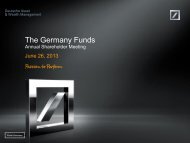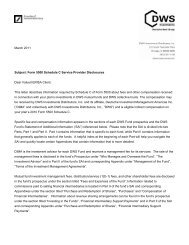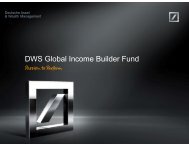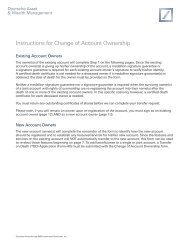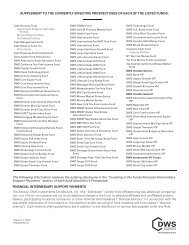Capital market bank funding - DWS Investments
Capital market bank funding - DWS Investments
Capital market bank funding - DWS Investments
You also want an ePaper? Increase the reach of your titles
YUMPU automatically turns print PDFs into web optimized ePapers that Google loves.
<strong>Capital</strong> <strong>market</strong> <strong>bank</strong> <strong>funding</strong>Balance sheet of European <strong>bank</strong>s: Liabilities side 2Percentage shares, Q2 2011100%80%60%40%20%0%DK FI SE LV MT UK IE NL LU FR HU RO LT EMU IT AT DE BE EE CY PT BG PL ES CZ GR SK SIDeposits Debt securities Money <strong>market</strong> funds External liabilities Other liabilities Equity capitalExternal: for euro members – creditor demiciled outside the euro area; for non-euro members – all non-residentsSources: ECB, DB ResearchThe majority of the long-term capital <strong>market</strong> <strong>funding</strong> has traditionally been seniorunsecured bonds, followed by secured debt paper such as Pfandbriefe or assetbackedsecurities. There are regional differences between secured debtinstruments: Pfandbriefe have enjoyed relatively high popularity for decadesalready, especially in Germany. In Anglo-American countries secured capital<strong>market</strong> <strong>funding</strong> has mainly taken the form of securitisations and asset-backedmoney <strong>market</strong> paper. As the image of securitisation suffered badly during thefinancial crisis, the appeal of Pfandbriefe could grow in these countries, too, infuture: in the UK in 2011 the share of issuance of mortgage-backed securitiescould already be seen to be declining; this decline was offset by a rise inPfandbrief issuance.Secured and unsecured <strong>funding</strong>With a secured bond the debtor deposits assets as collateral for the bond;established asset classes for this purpose include mortgages and other retailclient loans. With unsecured bonds, by contrast, creditors have no rights to anykind of collateral. In the case of insolvency the holders of unsecured bondsreceive payments from the insolvency assets according to their rank in the orderof priority. For the greater risk attached to an unsecured bond than to a securedbond investors are compensated with a higher return.Advantages of a secured instrument forinvestors 3ABS mostly generate higher returns for anidentical level of risk as the yield spreadprovides compensation for the early repaymentrisk, the redemption of the cashflows and theuniqueness of the instrument. Furthermore,investors are thereby enabled to invest inotherwise illiquid or inaccessible assets.Moreover, structured issues are often tailored tothe needs of investors. Securitisations can alsocarry with them a relatively low event risk, if thecover pool is sufficiently diversified and is thusrelatively immune to event risk.Common types of secured <strong>funding</strong>The securitisation of loans refers to the bundling of assets into a pool of differingtypes of contractual debts. These debts include, for example, home loans,commercial real estate loans, loans or promissory notes.In principle, everything that yields a predictable and stable cashflow can beused as collateral: all loans that are relatively homogeneous with regard to thegroup of creditors, maturity or interest rate risks can be pooled as collateral.Securitisation enables debt to be bundled and sold as bonds via pass-throughsecurities 3 in tranches with differing seniorities. Secured bonds can essentiallybe split into four categories:3With pass-through securities incoming cashflows from the asset pool are passed straight throughand unchanged to the owners of the ABS. The paper securitises proportional claims on the pool.4 | August 2, 2012 Current Issues
1998200020022004200620082010<strong>Capital</strong> <strong>market</strong> <strong>bank</strong> <strong>funding</strong>Volume of securitisation issuance inEurope 4USD m1,200,0001,000,000800,000600,000400,000200,0000Source: SifmaSecuritisation issuanceGermany (right)The Netherlands (right)200,000180,000160,000140,000120,000100,00080,00060,00040,00020,0000Market performance of structuredproducts in Europe 5USD m100%80%60%40%20%0%2000 2002 2004 2006 2008 2010Auto financingCredit cardsCDORMBSSource: SifmaConsumer creditLeasing contractsMBS CMBSOtherPfandbrief issuance by underlying 6Europe100%80%60%40%20%1. Asset-backed securities (ABS) 4 ,2. Mortgage-backed securities (MBS),3. Pfandbriefe and4. Securitised debt instruments such as collateralised debt obligations (CDOs).Asset-backed securitiesAs part of the process of issuing asset-backed securities a special-purposevehicle (SPV) is established to purchase assets from the originator andsecuritise them. 5 The securities are assessed by rating agencies and securedagainst default via overcollateralisation and the creation of a liquidity reserve.A distinction is drawn between true-sale and synthetic securitisations: with truesales the credit risk is transferred off the balance sheet to the investor, i.e. theoriginator’s balance sheet is reduced by the volume of the tranches that areplaced in the capital <strong>market</strong>. The asset items thus cease to be owned by theseller in their entirety, including all the associated risks. The risk-weightedassets are also reduced. With synthetic securitisations, by contrast, nocontractual transfer occurs, but only a transfer of some or all of the risksassociated with the asset with the aid of credit derivatives. Syntheticsecuritisations thus have no impact on the balance sheet, although here, too,the credit risk is transferred and the risk-weighted assets are reduced.The transfer of credit risk basically allows the redistribution of risk: the investor’sclaim is on the securitised cover pool, which is “static”, i.e. defaults or earlyrepayments are passed on straight to the investors. If the originator becomesinsolvent, payments can still be effected from the cover pool.Mortgage-backed securitiesMBS are ABS of a particular kind. MBS are bonds secured on private mortgageloans and are thus either residential mortgage-backed securities (RMBS) orcommercial mortgage-backed securities (CMBS). Residential mortgage-backedsecurities are the most important asset class of securitised products in Europe.Guarantees and the supervision of the collateral are as a rule not subject tostatutory regulation, but are agreed at the individual contract level.Pfandbriefe/Covered BondsPfandbriefe are a special type of secured bonds. They are covered by a specialpool of assets which in most cases “overcollateralises” the bond. There are alsoprecise legal provisions specifying what is permissible for packaging inPfandbriefe. These include, for example, claims on local, regional or nationalpublic-sector authorities or mortgage loans that do not exceed a specific,maximum loan-to-value ratio. The result is a high-quality bond that usuallyreceives a better rating than senior unsecured bonds from the same issuer.Thanks to the overcollateralisation Pfandbriefe also carry a very low investmentrisk: making a loss on an investment in Pfandbriefe would require in principleboth a default by the issuer and substantial losses on the underlying cover pool.The legal provisions, such as those for the German Pfandbrief 6 , also prescribe0%2003 2004 2005 2006 2007 2008 2009 2010Public-sector loans MortgagesShip loansMixedSource: ECBC456Typical forms of collateral are home loans, auto loans, credit card receivables or student loans.In the “pass-through process” the assets are effectively transferred to the SPV for legal andaccounting purposes. This process is the standard procedure, unlike the “pay-through process”,in which only cashflow from the assets are passed through. With synthetic securitisations basedon credit derivatives, by contrast, only the credit risk is sold.The German Pfandbrief <strong>market</strong> is regulated via the “Pfandbrief Act”, which ensures among otherthings that only mortgages with an LTV of up to 60% can be securitised in Pfandbriefe (Section5 | August 2, 2012 Current Issues
Jan 11FebMarAprMayJun200320042005JulAugSep20062007OctNovDec20082009Jan 12Feb2010MarApr<strong>Capital</strong> <strong>market</strong> <strong>bank</strong> <strong>funding</strong>Pfandbrief issuance 7EUR bn (left), % (right)250802006015040100205000Share of global volume (right)DEESNLFRGBSource: ECBCCDO issuance by underlying 8USD bn60050040030020010002000 2002 2004 2006 2008 2010High-yield bonds High-yield loansInvestment-grade bonds Structured financeOtherSource: SifmaBond issuance in 2011 / 2012 9USD bn per week706050403020100BondsPfandbriefeSource: Dealogicstrict rules for the selection of assets that may be used as collateral forPfandbriefe. Consequently, Pfandbriefe can as a rule be placed in the <strong>market</strong> ata lower premium than other asset-backed securities.The differences between MBS and Pfandbriefe: No balance-sheet transfer,dynamic cover poolIn contrast with ABS/MBS during the issuance process for Pfandbriefe there isdefinitely no balance-sheet transfer and thus no transfer of credit risk for theassets deposited as collateral. In addition, the investor’s claim is on a dynamiccover pool. This means that if a loan in the cover pool defaults or a loan isrepaid prematurely, it is be replaced by the issuer with a new, performing loan. Ifthe issuer become insolvent, the statutory trustee is responsible for thesettlement; with securitisations, by contrast, this is done by the investorsthemselves. Due to the “dual recourse” system, i.e. the right to assert a claim onthe issuer and if necessary the cover pool in the case of insolvency, Pfandbriefegenerate higher compensation in the case of a default than other structured orunsecured products.Collateralised debt obligations (CDOs)CDOs securitise assets that can take the form of bonds or loans. CDOs areissued by a special purpose vehicle, as are ABS. Value and payment terms areusually derived from a portfolio of fixed-income basic instruments. The differenttypes of CDOs are: collateralised loan obligations (CLOs) that comprise creditclaims; collateralised bond obligations (CBOs) that comprise traded bonds;collateralised synthetic obligations (CSOs), which are CDOs that are mainlybacked by credit derivatives; structured CDOs or commercial property CDOsand collateralised insurance obligations (CIOs), which are products backed byinsurance or reinsurance contracts. During the financial crisis many of a CDO’sassets were subprime MBS bonds, which is why the CDO <strong>market</strong> hascontracted significantly since the financial crisis.Bank <strong>funding</strong> has been changing since the crisisThe years preceding the crisis were marked by <strong>bank</strong>s relying more on the<strong>market</strong> for their <strong>funding</strong>, a rapid expansion in the securitisation <strong>market</strong> and acredit environment with low interest rates and high liquidity. Deposit <strong>funding</strong>, bycontrast, became less important. Banks increasingly funded their assets viashort-term debt in the form of repos or short-dated ABS. Securitisations wereone of the most important <strong>funding</strong> instruments for <strong>bank</strong>s: at their peak theyconstituted over 30% of long-term issuance by European <strong>bank</strong>s. The interestpremium for <strong>bank</strong>s also remained at a low level on account of low risk aversionin the <strong>market</strong>. The spreads between secured and unsecured bonds wererelatively small, i.e. the credit risks of both classes were given relatively similarratings.During the financial crisis it then became clear that these developments had,however, also been promoted by conflicts of interest along the securitisationchain, an inappropriately high level of confidence in the risk models of theratings agencies and a lack of transparency concerning the quality of theunderlying collateral and the business structures. These shortcomings resultedin the demand for secured products, particularly for securitisations in the form ofABS, collapsing during the crisis as investors withdrew from the <strong>market</strong>. The factthat securitisation has almost completely disappeared as a <strong>funding</strong> instrument14) and that the present values of the securities in circulation including an overcollateralisationare covered at all times (Section 4).6 | August 2, 2012 Current Issues
Jan-09Q1 05Q3 05Q1 06Q3 06Q1 07Q3 07Q1 08Q3 08Q1 09Q3 09Q1 10Q3 10Q1 11Q3 11May-09Sep-09Jan-10May-10Sep-10Jan-11May-11Sep-11Jan-12May-12<strong>Capital</strong> <strong>market</strong> <strong>bank</strong> <strong>funding</strong>Yield spreads 10Secured vs. unsecured, 6-month rates (%)3.02.52.01.51.00.50.0EURIBOR 6MEUR Repo is the rate for secured inter<strong>bank</strong>financing. The spread between EURIBORand EUR Repo is the unsecured <strong>funding</strong>premium.Source: Deutsche BankEUR Repo 6MIssuance by European <strong>bank</strong>s 11EUR bn (left). % (right)4003002001000Investment-grade bondsCovered bondsSources: Dealogic, DB ResearchCovered bond share (right)100806040200with the unfolding of the crisis is one reason why it has become increasinglydifficult for <strong>bank</strong>s to obtain capital <strong>market</strong> <strong>funding</strong> on a major or usual scale. 7The issue volumes of unsecured bonds also fell significantly during the crisis: inthe eurozone, for example, they dropped 8% in 2007 and by a further 13% in2008. Part of the reason for this was a shift in demand among investors. Whenproblems became apparent in the <strong>bank</strong>ing sector the initial response ofinvestors was to turn more frequently to other instruments that were supposedlysafe, such as government bonds. Issues of Pfandbriefe that were not retainedby the issuers 8 have also fallen since 2008. All the same, Pfandbriefe were akey contributor to the <strong>bank</strong>s in the eurozone even being in a position to maintainaccess to the capital <strong>market</strong> as the crisis continued.Recently there has even been a rise in the issuance of certain types of bond,especially Pfandbriefe: issuance of Pfandbriefe increased in 2011 to averagearound 45% of debt financing. Access to the capital <strong>market</strong> for <strong>bank</strong>s remains,however, impeded globally. In particular, it seems as if currently it is virtuallyonly <strong>bank</strong>s with good to very good credit ratings that are in a position to placeunsecured bonds in the <strong>market</strong> – and even then only at significantly higher coststhan before the crisis. Weaker <strong>bank</strong>s’ access to the unsecured bond <strong>market</strong> hasbeen severely restricted since the start of the crisis. For instance, issuance ofunsecured senior bonds fell to 38% of debt capital in Q2 2011, compared withan average figure of 51% since 2000.Investor interest in securitisations remains low, especially in Europe. The issuesexecuted since the crisis in the securitisation <strong>market</strong> have been drivenspecifically by non-<strong>market</strong>-related factors, such as public-sector programmes:they have been retained, for example, as collateral in order to obtain central<strong>bank</strong> liquidity.At the moment, too, many <strong>bank</strong>s can only obtain refinancing via short-term repoactivities or continued issuance of Pfandbriefe – if they avail themselves or canavail themselves of capital <strong>market</strong> <strong>funding</strong> at all. Conversely, the <strong>market</strong> forunsecured <strong>bank</strong> bonds in Europe continues to be fraught with major uncertainty.Q1 2012 in particular served as an indicator of how the sentiment would developin 2012 since redemptions were at their highest in the first quarter. Furthermore,issuers would normally have already funded the imminent redemptions three tosix months in advance; this, too, did not occur in 2011. Initially both the securedand unsecured <strong>bank</strong> bond <strong>market</strong>s in the EU made a relatively solid start in Q12012 – with weekly issue volumes of up to EUR 18.3 bn and partly at amoderate spread of 75 basis points above the 3-month Euribor. 9 A largeproportion of these placements were, however, executed by <strong>bank</strong>s that areregarded as very sound. Also, the ECB provided massive support for <strong>bank</strong>refinancing during the first quarter via its LTRO programme. Since April theoptimism, has, however, already subsided again; the <strong>market</strong> environment forcapital <strong>market</strong> <strong>funding</strong> remains difficult for the majority of <strong>bank</strong>s.<strong>Capital</strong> <strong>market</strong> <strong>funding</strong>: FactorsMany of the changes that have shaped the <strong>funding</strong> landscape since the crisiscould prove to be long-term trends that will be lasting impediments to <strong>bank</strong>financing. Essentially, there are six identifiable factors that have influenced longtermcapital <strong>market</strong> <strong>bank</strong> <strong>funding</strong> since the crisis and will continue to be majorinfluences in the next few years, too. These trends are: 1) the risk aversion of789ECB.Pfandbriefe that are not placed in the <strong>market</strong> can be used for example as collateral at central<strong>bank</strong>s or CCPs.At best, a maximum of eight Pfandbrief issues with a total volume of EUR 9.2 bn and six seniorunsecured bonds with a total value of EUR 9.1 bn could be placed in one week during Q1/12.7 | August 2, 2012 Current Issues
<strong>Capital</strong> <strong>market</strong> <strong>bank</strong> <strong>funding</strong>investors, 2) the continuing perception that there is low transparency concerningthe risks attached to the debt securities, 3) the ongoing central <strong>bank</strong> measures,4) the new regulatory requirements, 5) the dearth of access to high-qualitycollateral and 6) the relative volume of encumbered assets.1) Risk aversion of investorsRisk premia for <strong>bank</strong> bonds have notyet recovered 12iBoxx Euro Bank debt indices, asset swapspread (bp)1000800600400200006 07 08 09 10 11 12Senior bondsSource: Deutsche BankSub-senior bondsRisk premia for eurozone are not on arecovery course 13iBoxx EUR Eurozone index level2001601208006 07 08 09 10 11 12Source: Deutsche BankSince the financial crisis there has been a sharp increase in investors’ riskaversion. This has also hit the <strong>bank</strong>ing sector in particular, with investorscurrently looking primarily for a safe home for their capital rather than for yield.The pre-crisis “search for yield” has now become a “flight to quality andsimplicity”. This trend is being driven by concerns about i) the creditworthinessof certain issuers, ii) systemic risks and iii) the <strong>bank</strong>s’ balance sheets which areregarded as opaque.This risk aversion will probably only recede significantly once there is aneconomic recovery and greater certainty concerning the solution of theEuropean sovereign debt crisis. One decisive factor will thus be whetherEuropean policymakers succeed in presenting a credible plan for rebuildingconfidence in the <strong>market</strong> in future and for the long term. For example, some50% of respondents to the “Fixed-Income Investor Survey” conducted by Fitchwere of the opinion that solving the European sovereign debt crisis alone wouldresult over the long term in <strong>bank</strong> bonds again being seen as a worthyinvestment. Initiatives such as more stringent capital standards, clarityconcerning the resolution mechanisms and limits on assets that can be used ascollateral will, however, not be enough to re-establish confidence in thecreditworthiness of the <strong>bank</strong>s.Moreover, the positive correlation between sovereign debt and <strong>bank</strong> risks hasincreasingly not only had an impact on the unsecured bond <strong>market</strong>s, but also onsecuritised debt instruments: <strong>market</strong> activities in the securitisation segment arealmost only conducted in the countries with limited risks attached to theirsovereign debt and a relatively robust economic situation. 10 The “Covered BondInvestor Survey” from Fitch Ratings also finds that investors are only planning toincrease their investments in Pfandbriefe in certain regions; for example inScandinavia, Canada, Australia, the UK and the Netherlands. The survey alsoshows that, since the crisis, investors have displayed little desire to experimentwith regard to the type of collateral for Pfandbriefe: for example, only 35% ofrespondents would feel confident buying Pfandbriefe that are backed by assetsother than mortgages or public bonds – and they would only do so at higherspreads. Plans by issuers to back Pfandbriefe with less traditional assets suchas SME loans thus currently appear to offer relatively little prospect of success.Overall, the conclusions that can thus be made are that firstly the risk aversionof investors has risen significantly since the crisis erupted, and that secondlythis will also remain the case for the time being – especially as long as the<strong>market</strong> situation does not improve significantly.2) Low transparency concerning the risks takenThe change in investors’ risk aversion is also particularly influenced by theperception that transparency is low. The risks associated with theseintransparencies are very difficult to quantify for investors. Furthermore, the lackof transparency leads to information asymmetries, which further increases therisk aversion of investors.The perception of insufficient transparency is based mainly on two factors: i) thefundamental implicit and explicit risks in <strong>bank</strong>s’ balance sheets which investors10 ECB.8 | August 2, 2012 Current Issues
<strong>Capital</strong> <strong>market</strong> <strong>bank</strong> <strong>funding</strong>Pros and cons of more stringent disclosureobligations 14Pros:— Market participants can make decisions ona sounder basis if they are better informed.This means that investors feel less exposedto <strong>market</strong> uncertainty— The credibility of the information can beassessed more accurately— More stringent disclosure obligationsprovide <strong>bank</strong>s with positive behaviouralincentives, for example to guarantee morerisk-commensurate conditions, or to limit perse specific volumes/types of business— Provide the <strong>bank</strong> with signallingopportunities— Can have an economic impact: systemicrisks are limited, as <strong>market</strong> participants canbe more discriminating thanks to theimproved information situation; bolstersmonitoring opportunities for shareholdersand <strong>bank</strong>ing supervision measuresCons:— Potential <strong>market</strong> overreaction— Contagion dangers for other <strong>bank</strong>s and— Costs (in particular there is an incentiveproblem, since the beneficiary of theinformation does not pay the costs)are often incapable of gauging and ii) uncertainty about the quality of the (cover)assets, i.e. uncertainty about what an investor actually receives in the case ofan insolvency.The background is that <strong>bank</strong>s usually do not have to supply detailed informationabout which of their assets are encumbered and where. Also, with secured<strong>funding</strong> instruments the transparency about the quality and quantity of publiclyavailable information about the cover pool is decisive, because this indicateswhich financial assets are encumbered as collateral and what the quality ofthese assets is.Current measures consistently attempt to guarantee greater transparency in the<strong>market</strong>s and especially in the securitisation <strong>market</strong>s. In October 2011, forexample, the Financial Stability Board (FSB) published a consultation documenton new principles for subscribing to RMBS, and from summer 2012 the ECBintends to require that <strong>bank</strong>s submit loan-level information on the ABS theydeposit as collateral with the ECB. A data portal is planned for this purpose, andit is also to be made accessible to investors and the general public.Another initiative aimed at generating improved quality signals in thesecuritisation <strong>market</strong>s is the “Prime Collateral Securities” (PCS) programme. It isa “securitisation labelling initiative” that is currently being pursued by theEuropean financial industry spearheaded by the European Financial ServicesRound Table (EFR). The objective is to create a new segment in thesecuritisation <strong>market</strong> and to thereby rehabilitate securitisation – a product whoseimage has been so adversely affected by the crisis. The idea of setting astandard for securitisations is not a new one and has also already beenpractised for several years in the German <strong>market</strong>, for example in the form of TSIcertification. 11The PCS programm 15The PCS programme aims to design acomprehensive <strong>market</strong> convention that is basedprimarily on standardisation and transparencyas well as creating a brand with specificqualitative attributes. By combining this withother supporting activities such as <strong>market</strong>makingthe aim is thus to generate sufficientand above all crisis-proof liquidity in the primaryand secondary <strong>market</strong>s.3) Central <strong>bank</strong> measuresSince the financial crisis erupted central <strong>bank</strong>s have adopted a variety ofmeasures to prop up financial <strong>market</strong>s. These measures include:— In the US: “quantitative easing” by the Fed, which resulted in large volumesof liquidity being pumped into the <strong>bank</strong>ing system. 12 The Fed’s measuresincluded USD 2.3 tr of asset purchases, spent on MBS and US Treasuries.— In the UK: the Bank of England’s “Special Liquidity Scheme” (SLS), whichallowed <strong>bank</strong>s to swap MBS or Pfandbriefe for government bonds in orderto maintain <strong>market</strong> liquidity.— In the eurozone: the ECB is supporting <strong>bank</strong> <strong>funding</strong> by granting full tenderallotment to generate liquidity. 13 This has enabled <strong>bank</strong>s that depositedcollateral to borrow from the ECB at low rates and thereby to obtain central<strong>bank</strong> liquidity.The ECB has also supported the Pfandbrief <strong>market</strong> via its EUR 60 bncovered bond purchase programme (CBPP). Under the CBPP, the ECB haspurchased Pfandbriefe that satisfy minimum quality standards, therebyensuring liquidity in this <strong>market</strong> segment.11 The True Sale International (TSI) certification was created in 2004 following an initiative by 13<strong>bank</strong>s to promote and develop the German securitisation <strong>market</strong>. The aim is for <strong>bank</strong>s tosecuritise their loans via a standardised process agreed with all <strong>market</strong> participants and therebyto ensure that TSI-certified securitisation transactions conform to a high standard with regard totransparency, investor information and <strong>market</strong>-making.12 The Fed halted its liquidity measures in March 2012.13 The “longer term refinancing operation” (LTRO) is an element of the liquidity provision. InDecember 2011 a first three-year LTRO tender was launched; a second was launched at the endof February 2012.9 | August 2, 2012 Current Issues
<strong>Capital</strong> <strong>market</strong> <strong>bank</strong> <strong>funding</strong>The impact of these central <strong>bank</strong> measures on <strong>bank</strong> <strong>funding</strong> can be split intodirect and indirect effects: the direct effect stems from programmes such as theECB’s CBPP, which provides incentives for <strong>bank</strong>s to issue a certain type ofbond – in this case Pfandbriefe. The central <strong>bank</strong> thereby enhances the appealof one instrument relative to other instruments. One indirect effect arises, on theone hand, from the fact that <strong>bank</strong>s wanting to obtain liquidity from the central<strong>bank</strong> require assets/securities/cash in order to deposit them as collateral withthe central <strong>bank</strong>. Since the financial crisis erupted ABS and unsecured <strong>bank</strong>bonds, for example, have made up the lion’s share of collateral in theEurosystem (see chart 16). On the other hand, the relative appeal of the assetschanges: “quantitative easing” for example results in government bondsbecoming more liquid.Eurosystem collateral by asset class 16EUR bn2,2502,0001,7501,5001,2501,00075050025002004 2005 2006 2007 2008 2009 2010Government bonds (central government)Unsecured <strong>bank</strong> bondsCorporate bondsOther <strong>market</strong>able assetsGovernment bonds (regional government)PfandbriefeAsset-backed securitiesOther non-<strong>market</strong>able assetsSource: ECB4) The new regulatory environmentThe new regulatory framework for the <strong>bank</strong>ing sector will also have a long-termimpact on <strong>funding</strong> <strong>market</strong>s and alter the preferences of investors. The initiativesinclude the planned bail-in mechanisms – with the associated removal of theimplicit taxpayers’ guarantees for bondholders – and the new Basel III liquidityand capital standards. These initiatives will permanently alter investors’perception of the risk attached to <strong>bank</strong> bonds.Cross-fertilisation with other initiatives 17The new regulatory standards for insurancecompanies, Solvency II, also seek to improvethe liquidity profiles of insurers. As January2013 will see the implementation of both thenew capital and liquidity standards for <strong>bank</strong>s(Basel III), and the new capital adequacy regimefor insurance companies (Solvency II), andinsurers are major institutional investors – alsoin <strong>bank</strong> bonds – cross-fertilisation resulting fromthis joint implementation cannot be ruled out(see Zähres, 2011).Solvency II also contains strict capital standardsfor securitised instruments, such as ABS andstructured financial products, but not forPfandbriefe. The capital standards thus makePfandbriefe more attractive for insurancecompanies and ABS less attractive.Basel III capital and liquidity standardsIn December 2010 the Basel Committee published its proposals for newstandards on <strong>bank</strong> capital adequacy and liquidity (Basel III). These include theintroduction of two regulatory standards, the NSFR and the LCR, which aim toput <strong>bank</strong> <strong>funding</strong> on a more sound basis.Net Stable Funding Ratio (NSFR)The aim of the NSFR is the reduction of mismatches between the maturitystructures of assets and liabilities in <strong>bank</strong>s’ lending and deposit activities, i.e. toensure matched maturity <strong>funding</strong>. Funding gaps beyond the LCR time horizonare also to be averted (see below). The objective of the NSFR is thus that <strong>bank</strong>smust be able to ensure their long-term <strong>funding</strong> more independently of thecurrent <strong>market</strong> situation and more stably. In turn, <strong>funding</strong> instruments regardedas stable are those with a reliable availability of at least one year such as10 | August 2, 2012 Current Issues
<strong>Capital</strong> <strong>market</strong> <strong>bank</strong> <strong>funding</strong>supervisory capital, other capital and liabilities or stable deposits (from retailclients and SMEs).The NSFR is thus a dynamic variable: if <strong>bank</strong>s want to be involved in certainbusinesses, they have to possess the corresponding <strong>funding</strong> structure, in orderto even out possible mismatches.Liquidity coverage ratio (LCR)Another element of the new Basel III liquidity standards is the LCR. The purposeof this standard is to provide a liquidity buffer for a 30-day period, i.e. theavailability of a minimum quantity of highly liquid assets. Examples of assetsdeemed to be liquid are cash, debt securities with little or no risk weighting andassets that are eligible for refinancing at central <strong>bank</strong>s and always <strong>market</strong>able 14 .The aim is to ensure an individual <strong>bank</strong>’s ability to withstand an event of acuteliquidity stress.Resolution regime at EU level 18In June 2012, the European Commissionpresented its long-delayed proposals on <strong>bank</strong>resolution and crisis management. This billseeks to provide a harmonised approach todealing with ailing financial institutions. Thelegislation is planned as a directive, with theresolution authority to rest with the memberstates. The Commission’s proposal will nowenter into the legislative process. Uncertaintyexists above all with regard to the question ofexactly which instruments will be required to bewritten down and the ranking of creditors in thecase of insolvency. Additional uncertainty hasbeen created by recent political decisions tocreate a “<strong>bank</strong>ing union”, as a workable EUwideresolution regime would obviously need tobe part of such a <strong>bank</strong>ing union but it is unclearwhether the proposal currently on the tablewould be sufficient.Sources: Deutsche Bank, European CommissionRestructuring procedures and bail-in mechanismsFurther regulatory innovations with an impact on <strong>bank</strong> <strong>funding</strong> are the plannedchange in bondholder liability and the restructuring procedures for financialinstitutions managed by supervisory authorities.The restructuring regimes currently being introduced or planned in manycountries (in Germany, for example, the Bank Restructuring Act) will change theway that <strong>bank</strong>s are treated if their existence is threatened. The new measuresallow, for example, the responsible supervisor to dismiss and replace seniormanagement and to nominate an administrator to take charge of the <strong>bank</strong> andrestructure it. The rights of shareholders can also be overridden temporarily, forexample as regards transactions that would normally require the consent ofshareholders. Also, the supervisor is given the authority to implement a bail-in,i.e. to write down the value of bonds or convert them into equity. A bail-in isdesigned so that losses are passed on to the bondholders without the entire<strong>bank</strong> having to be liquidated (see below).The restructuring regimes will put unsecured bondholders in a worse positionthan up until now. This is particularly the case compared to investors in securedbonds, since they are usually excluded from liquidation mechanisms and theirclaims are also backed by high-quality assets.The objective of the bail-in mechanisms is for bondholders to share the costs ofcrisis management prior to insolvency. During the financial crisis bondholdersremained largely unaffected as nearly all <strong>bank</strong>s were bailed out by the statebecause of their importance for the financial system; the payment claims of evenjunior bond investors were maintained, and they were only liable in the event ofinsolvency proceedings. In future, the risks attached to senior and junior bondsare to be reflected more appropriately in the conditions.The possibility of implementing a bail-in, i.e. of writing down the value of bondsor converting them into equity is therefore part of the restructuring regime inmost regulatory initiatives. 15 Bail-ins will be accompanied by new rights ofintervention for supervisory authorities, since these will decide on the right timefor a waiver of claims, which then will, in all likelihood, affect all juniorbondholders and could possibly even affect senior bondholders, too. Ofparticular concern in this regard is the prospect of “bail-in” proposals that leavethe timing and the size of the haircut at the sole discretion of the supervisoryauthorities, as the event of a write-down for investors cannot then be gauged inadvance or predicted.14 Particularly in terms of eligibility for repo operations.15 The UK, too, has a bail-in rule: the Banking Act of 2009.11 | August 2, 2012 Current Issues
<strong>Capital</strong> <strong>market</strong> <strong>bank</strong> <strong>funding</strong>The possibility of a bail-in will probably mean that the <strong>market</strong> for unsecuredbonds will become (even) more inaccessible to <strong>bank</strong>s with lower credit ratings.After all, one can assume that as soon as the possibility of an involuntary waiverof claims is introduced in a regulation then tail risks will become a problem, asthe likelihood of these risks materialising will rise. This applies in particular tothose <strong>bank</strong>s that are perceived by the <strong>market</strong> as not being absolutely sound.The options for a <strong>bank</strong> to place unsecured bonds will in future hinge on theresistance of the <strong>bank</strong> to a potential bail-in.Interim conclusion: Stronger demand for high-quality financial instrumentsThe strong risk aversion and the perception that transparency is low areresulting in increased demand for financial instruments that are regarded assafe, such as Pfandbriefe. This asset class is thus likely to continue becomingmore appealing going forward. Market demand for other secured products suchas securitisations, by contrast, is currently mainly only for products whosecollateral has a good <strong>market</strong> rating, i.e. with a very low risk profile and from alow-risk country.Also, the new regulatory standards could in practice encourage greater use ofPfandbriefe, since Pfandbriefe can under certain circumstances be assigned tothe LCR as an element of the “liquid assets” and they are also a cost efficientmeans of lengthening the maturities of <strong>bank</strong> liabilities as part of the NSFR.Within the secured bonds segment the new standards could thus lead todemand shifting further away from securitisations towards Pfandbriefe.The demand structure in recent years subsequent to the crisis has alreadyshown that investors appear to be examining products more closely and aredisplaying a preference for transparent, simple and proven product structures.Other key factors for investors at present also are low-risk collateral and thereputation of the issuer.5) Limited availability of high-quality collateralThe developments discussed up until now do indicate a shift towards securedbonds, especially Pfandbriefe. Since the supply of high-quality assets for thecover pool is limited, however, there are limits to the issuance of secured bonds.In addition, worse macroeconomic conditions, rising unemployment and lowerconsumption have generally dampened lending and thus reduced the availabilityand quality of collateral recently.As an alternative to Pfandbriefe there could be an increase in the issuance ofother secured bonds, such as ABS, since the collateral requirements are lessrestrictive for this type of bond. However, as part of the process of learninglessons from the crisis a revision of underwriting practices is currently inprogress, which will probably limit the choice of collateral in future. To date, the<strong>market</strong> for securitisations has not yet been able to recover. The most recentissuance activities, for example in the UK, Spain or the US, do suggest a slightpick-up in the securitisation <strong>market</strong>. ln the US to date, however, it has mainlybeen only the government-backed mortgage securities that could be placed; inGermany it has mainly been ABS backed by auto loans and in the Netherlands,for example, those backed by residential mortgages. Demand has, however,been largely limited to the senior tranches of these products. In the long termsecuritisations will only then “get back on their feet” when all tranches of asecuritised product can be placed – including the equity tranche and themezzanine tranches.Besides the quality of the collateral what is also a key factor is the enforceabilityof collateral in the event of insolvency. If this is not the case, then the highestqualitycollateral is of no use.12 | August 2, 2012 Current Issues
<strong>Capital</strong> <strong>market</strong> <strong>bank</strong> <strong>funding</strong>6) Relative volume of encumbered assets limits the volume of secured bondsThe greater use of secured bonds and in particular Pfandbriefe is limited notonly by the dearth of high-quality collateral, but also by the ratio ofunsecured/secured bonds in the <strong>funding</strong> mix.A high ratio of secured bonds means that fewer and fewer high-quality assetsare available to service the claims of the remaining creditors. For example,unsecured bondholders would have fewer rights to the high-quality assets in theevent of insolvency.The share of secured liabilities is thus relevant for the financial institution bothwith regard to the investor’s valuation and also in connection with the creditrating: too many encumbered assets and a highly leveraged balance sheetinfluence the rating for unsecured bonds, as rating agencies take the recoveryrate into account. The higher the balance sheet leverage and the bigger therelative share of secured bonds, the lower in turn the recovery rate. True, thereis no universally applicable threshold above which the share of secured bonds isperceived to be “too high”, as this also depends on the individual businessmodel and the quality and structure of the assets. Bank of America Merrill Lynchhas, however, calculated that with a Pfandbrief issue volume to assets ratio of40% the senior unsecured creditors would have no claims to assert in the eventof an insolvency. 16The issuance of secured bonds such as Pfandbriefe also results in theencumbrance not only of many assets, but especially of high-quality assets. Thismakes overall <strong>funding</strong> less flexible. The very attribute that makes Pfandbriefesuch safe investments is what makes them dubious for holders of other <strong>bank</strong>bonds. This is because the increasing issuance of Pfandbriefe results in theclaims of senior bondholders being “subordinated”: the higher the volume ofencumbered assets, the higher the credit risk for senior unsecured bondholdersin the event of insolvency. Unsecured bondholders will thus not only be subjectto stricter liability rules in future, they will also be treated as “moresubordinated”.Issuance of different types of secured bond also result in <strong>bank</strong> liabilities beingsplit into more tranches: what begins as a relatively simple liability structure, inwhich many creditors enjoy the same rank, ends up as a liability structure withmany differing seniorities.Secured <strong>funding</strong>: Limited optionsTo sum up, the current <strong>market</strong> environment means that secured bonds, andespecially Pfandbriefe, can be placed far more successfully than unsecuredbonds. The encumbrance of balance sheet assets by the issuance of securedbonds does, however, also harbour long-term risks and can jeopardise theissuance of unsecured bonds. Price advantages that accrue from issuingPfandbriefe could thus be offset, at least partly, by the demands of unsecuredbondholders for higher compensation to cover the default risk.The questions about sufficient high-quality collateral and the <strong>bank</strong>s’ leverage,and the associated structural subordination of senior bondholders, result insecured bonds also continuing to make up only a meagre share of the <strong>bank</strong><strong>funding</strong> mix. The use of secured <strong>funding</strong> also subsequently restricts the choiceof lending activities, since not all assets can be used as collateral. AlthoughPfandbriefe are thus becoming more attractive and unsecured bonds arebecoming less attractive and/or more expensive, since unsecured creditors are16 Fitch also cites a ratio of around 50/50 as a “tolerance limit” before the unsecured liabilities aredowngraded.13 | August 2, 2012 Current Issues
<strong>Capital</strong> <strong>market</strong> <strong>bank</strong> <strong>funding</strong>worse off in the “new world” than before 17 , the options open to <strong>bank</strong>s indetermining their <strong>funding</strong> mix are limited. The option of using securitisation as a<strong>funding</strong> instrument is currently closed also because there is still a lack ofinvestor confidence. Initiatives such as the above-mentioned PCS programmeare therefore attempting to create a securitisation-based <strong>funding</strong> alternative toPfandbriefe and unsecured bonds.Overall, <strong>bank</strong>s currently find themselves in a sticky situation as regards their<strong>funding</strong> options: the current situation would support the issuance of securedbonds, but the actual options for procuring debt capital in this way are limited.Summary: Impact of trends on individual types of bond 19Trend / impact of trend on bond type Unsecured ABS MBS Pfandbrief CDOInvestor risk aversionLow transparencyCentral <strong>bank</strong> measuresRegulatory environmentLack of availability of high-quality collateralRelative volume of encumbered assetsOverall impact of the trends on the appeal of the respective bondtypeConclusion:In many European countries Pfandbriefe have gained popularity since the crisisand are increasingly becoming a complementary <strong>funding</strong> instrument, especiallyto RMBS. 18 In the last two years Pfandbriefe were the main source of long-termcapital <strong>market</strong> <strong>funding</strong>.In the future, too, both the demand and supply sides will see incentives emergethat favour the issuance of secured bonds, especially Pfandbriefe, as generallyhigh <strong>funding</strong> costs are continuing to boost the supply of relatively cheap secured<strong>funding</strong>.Overall, the developments discussed are likely to result in unsecured senior<strong>bank</strong> bonds becoming less attractive to investors in future or at least moreexpensive for issuers. In future they will be perceived as more risky, forexample, on account of the current debate about the resolution regime and thepolitical objective of involving <strong>bank</strong> bondholders in meeting the costs of <strong>bank</strong>restructuring in order to avert bail-outs by the taxpayers. <strong>Capital</strong> <strong>market</strong> <strong>funding</strong>of <strong>bank</strong>s and in particular the costs of unsecured <strong>funding</strong> will thus remain at astructurally higher level than prior to the crisis for a sustained period.Several <strong>bank</strong>s will thus have to carry out a fundamental rethink of their <strong>funding</strong>mix, since the <strong>market</strong> price that a <strong>bank</strong> has to pay for unsecured senior debt is a17 This trend has steadily reduced investor demand for senior unsecured <strong>bank</strong> bonds since 2010.18 ECB.14 | August 2, 2012 Current Issues
<strong>Capital</strong> <strong>market</strong> <strong>bank</strong> <strong>funding</strong>Structured Pfandbriefe 20A structured Pfandbrief is similar to aconventional Pfandbrief, with the only differencethat the former is not subject to the sameregulatory framework as the latter. StructuredPfandbriefe enhance many of the positiveattributes of Pfandbriefe in principle, such asovercollateralisation, rights of recourse, amongother things to other additional asset classes –without the established legal structures thatapply to traditional Pfandbriefe.pivotal factor in their business model. If <strong>bank</strong>s are unable to gain access to theusual volume of <strong>funding</strong> over the long term, they will have to shrink their balancesheets in order to be able to maintain their existing capital structure. Theconsequence is that <strong>bank</strong>s will have to reduce their assets or make greater useof other additional sources of <strong>funding</strong> or a different mix of <strong>funding</strong> instruments.Structurally higher <strong>funding</strong> costs will in any event weigh on <strong>bank</strong>s’ profitability infuture.Investors in <strong>bank</strong> bonds will in future either demand higher yields on unsecuredbonds or increased cover in the form of collateral. Since, however, collateral isonly available in limited amounts, capital <strong>market</strong> <strong>bank</strong> <strong>funding</strong> could contractover the next few years. In order to overcome <strong>funding</strong> constraints in the capital<strong>market</strong> an increase in deposit <strong>funding</strong> would be conceivable. 19Another possibility would be the development of other alternatives to moreexpensive unsecured senior debt <strong>funding</strong>; e.g. structured Pfandbriefe or loanfunds. Should new forms of collateral also be used, they would, however, in anyevent have to be guaranteed as being of sufficient quality. At present, though,investors still appear to be sceptical about securitisations in general and new,unconventional forms of collateral in particular.Up until about five years ago nearly all <strong>bank</strong>s had no problems with <strong>funding</strong>.Now it is becoming increasingly clear that capital <strong>market</strong> <strong>funding</strong> for <strong>bank</strong>s willbe in short supply in future.Meta Zähres**The author would like to thank Irina Clemens for her valuable support in producing this report.19 For more on deposit <strong>funding</strong>, see Ahlswede, Schildbach (2012).15 | August 2, 2012 Current Issues
<strong>Capital</strong> <strong>market</strong> <strong>bank</strong> <strong>funding</strong>Selected literatureAhlswede, S. (2011). Bank <strong>funding</strong> of residential mortgages in the EU.EU Monitor. August 2011. Deutsche Bank Research. Frankfurt am Main.Ahlswede, S. and J. Schildbach (2012). Poised for a comeback: Bank deposits.Why <strong>bank</strong>s should <strong>bank</strong> on savings accounts after all. Current Issues. May2012. Deutsche Bank Research. Frankfurt am Main.European Commission (2011). Recent Developments in Securitisation. February2011.Fitch Ratings (2012). Covered Bond Investor Survey Year-End 2011 – Growingbut Selective Appetite for the Asset Class. January 16, 2012Fitch Ratings (2011). Trends in Bank Funding Profiles – Secured Financing onthe Rise, But Likely to Tail Off. 16. June 2011.Wolter, J. (2011). Nordic Banks: EU Bank Resolution & Bail-in proposal back onthe table. November 23, 2011. Deutsche Bank, Global Markets Research.Zähres, M. (2011). Solvency II and Basel III: Reciprocal effects should not beignored. Current Issues. September 22, 2011. Deutsche Bank Research.Frankfurt am Main.© Copyright 2012. Deutsche Bank AG, DB Research, 60262 Frankfurt am Main, Germany. All rights reserved. When quoting please cite “DeutscheBank Research”.The above information does not constitute the provision of investment, legal or tax advice. Any views expressed reflect the current views of the author,which do not necessarily correspond to the opinions of Deutsche Bank AG or its affiliates. Opinions expressed may change without notice. Opinionsexpressed may differ from views set out in other documents, including research, published by Deutsche Bank. The above information is provided forinformational purposes only and without any obligation, whether contractual or otherwise. No warranty or representation is made as to the correctness,completeness and accuracy of the information given or the assessments made.In Germany this information is approved and/or communicated by Deutsche Bank AG Frankfurt, authorised by Bundesanstalt fürFinanzdienstleistungsaufsicht. In the United Kingdom this information is approved and/or communicated by Deutsche Bank AG London, a member ofthe London Stock Exchange regulated by the Financial Services Authority for the conduct of investment business in the UK. This information isdistributed in Hong Kong by Deutsche Bank AG, Hong Kong Branch, in Korea by Deutsche Securities Korea Co. and in Singapore by Deutsche BankAG, Singapore Branch. In Japan this information is approved and/or distributed by Deutsche Securities Limited, Tokyo Branch. In Australia, retail clientsshould obtain a copy of a Product Disclosure Statement (PDS) relating to any financial product referred to in this report and consider the PDS beforemaking any decision about whether to acquire the product.Printed by: HST Offsetdruck Schadt & Tetzlaff GbR, DieburgPrint: ISSN 1612-314X / Internet/E-mail: ISSN 1612-3158



